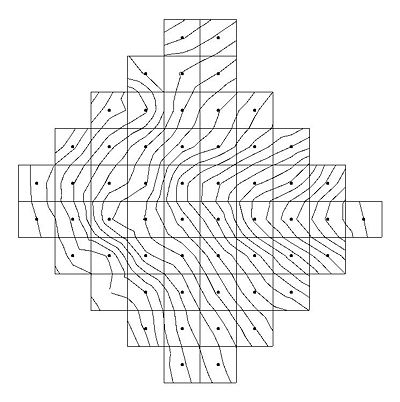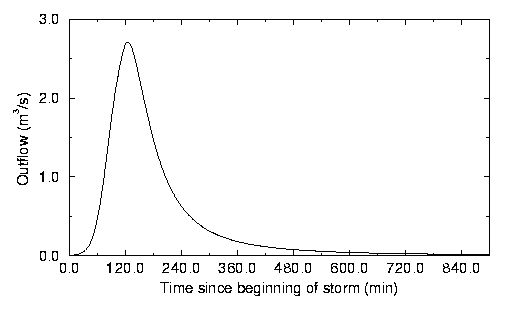Template:GUM15
15 - Creating Project Files
The following sections provide examples to illustrate the typical form of project files for three situations. The first project file represents the bare minimum input requirements for running GSSHA for a single event with spatially uniform surface roughness and rainfall, without infiltration or channel routing. The second project file shows the required cards for an event simulation with spatially varied rainfall, surface roughness, infiltration and channel routing. The third example shows a project file for GSSHA running in the continuous simulation mode with fully spatially varied inputs.
15.1 Simple Project File
For this project file example, we use an invented watershed data set. The topography of the watershed is shown in the Figure 15 with a 50 m resolution GSSHA grid overlay:
This watershed has a mask map which is appears as (with contrived coordinates):
north: 11000.0 south: 10500.0 east: 2000.0 west: 1500.0 rows: 10 cols: 10 0 0 0 0 1 1 0 0 0 0 0 0 0 1 1 1 0 0 0 0 0 0 1 1 1 1 1 0 0 0 0 1 1 1 1 1 1 1 0 0 1 1 1 1 1 1 1 1 1 0 1 1 1 1 1 1 1 1 1 1 0 1 1 1 1 1 1 1 1 0 0 0 1 1 1 1 1 1 0 0 0 0 0 1 1 1 1 0 0 0 0 0 0 0 1 1 0 0 0 0 |
In addition, the watershed digital elevation model from which the Figure 15 was derived (using WMS) appears as:
north: 11000.0 south: 10500.0 east: 2000.0 west: 1500.0 rows: 10 cols: 10 0.0 0.0 0.0 0.0 89.6 85.7 0.0 0.0 0.0 0.0 0.0 0.0 0.0 86.1 83.1 80.3 0.0 0.0 0.0 0.0 0.0 0.0 96.7 92.8 80.7 74.8 69.2 0.0 0.0 0.0 0.0 98.9 90.1 83.5 76.2 71.9 64.8 59.8 0.0 0.0 100.0 92.5 85.5 80.9 66.9 60.3 54.6 50.5 41.5 0.0 101.1 94.6 80.8 77.3 70.2 62.1 50.2 43.2 35.6 30.3 0.0 97.2 94.8 81.2 77.4 68.6 61.1 52.6 44.9 0.0 0.0 0.0 95.2 92.2 82.5 73.8 66.1 61.4 0.0 0.0 0.0 0.0 0.0 94.7 84.9 79.3 71.7 0.0 0.0 0.0 0.0 0.0 0.0 0.0 87.0 81.3 0.0 0.0 0.0 0.0 |
The mask and elevation maps were saved in files name “mask.map” and “elev.map”, respectively. Notice that the outlet of the catchment is in row 6 and column 10 of the DEM. This is the lowest point on the perimeter of the watershed. Also notice that the headers for the two maps are identical, and that the grids are square, and 50 m in size.
The following represents the simplest possible project file to run GSSHA. This project file will run GSSHA with a spatially uniform Manning roughness coefficient equal to 0.036 and with spatially uniform rainfall at a rate of 80.0 mm/h for a duration of 2 h (120 min). The simulation will run for 2000 min. The outlet hydrograph will be output every 30 minutes. Notice that lines that begin with the pound sign are comments, which are allowed in the project file.
GSSHAPROJECT #The only 2 required maps. WATERSHED_MASK simple.msk ELEVATION simple.ele #Required watershed geometrical information. GRIDSIZE 50.0 ROWS 10 COLS 10 #Run duration information. TOT_TIME 2000 TIME STEP 20.0 #The next 3 lines req’d because no channel routing. OUTROW 6 OUTCOL 10 OUTSLOPE 0.106 #Spatially-uniform overland flow roughness. MANNING_N 0.036 #Rainfall input. PRECIP_UNIF RAIN_INTENSITY 80.0 RAIN_DURATION 120 #Following two lines required only for spatially-unif. rainfall. START_DATE 1997 7 17 START_TIME 22 20 #Required output files. SUMMARY simple.sum HYD_FREQ 30 OUTLET_HYDRO simple.hyd |
Without the comments, the project file is more readable:
GSSHAPROJECT WATERSHED_MASK simple.msk ELEVATION simple.ele GRIDSIZE 50.0 ROWS 10 COLS 10 TOT_TIME 2000 TIME STEP 20.0 OUTROW 6 OUTCOL 10 OUTSLOPE 0.106 MANNING_N 0.036 PRECIP_UNIF RAIN_INTENSITY 80.0 RAIN_DURATION 120 START_DATE 1997 7 17 START_TIME 22 20 SUMMARY simple.sum HYD_FREQ 30 OUTLET_HYDRO simple.hyd |
This project file is saved under the name “simple.prj”. GSSHA is run by typing the command “GSSHA simple.prj”. For this example, the following outflow hydrograph is the result:
15.2 Involved Project File
Infiltration can be included in the simulations using one of the optional methods. For the sake of this example, Green & Ampt infiltration will be simulated, which requires additional inputs of porosity, saturated hydraulic conductivity, capillary head parameter, and initial water content as maps or as Mapping Table inputs related to index maps. We will assume that these data are saved in maps named “simple.por”, “simple.sat”, “simple.cap”, and “simple.moi”, respectively. Spatially distributed rainfall will also be input, with two rain gages using inverse distance squared interpolation. The rainfall data are stored in a file called “simple.gag”. A single channel, which consists of two links, will also be simulated. The channel input data file will be called “simple.cip”, with a the channel/grid connectivity file "simple.gst". The format of the channel input files is described in Chapter 5.
The resulting project file for this simulation appears as:
GSSHAPROJECT WATERSHED_MASK simple.msk ELEVATION simple.ele QUIET GRIDSIZE 50.0 ROWS 10 COLS 10 TOT_TIME 2000 TIME STEP 20.0 MANNING_N 0.036 PRECIP_FILE simple.gag RAIN_INV_DISTANCE GREEN_AMPT POROSITY simple.por CONDUCTIVITY simple.sat CAPILLARY simple.cap MOISTURE simple.moi CHAN_EXPLIC CHANNEL_INPUT simple.cip STREAM_CELL simple.gst SUMMARY simple.sum HYD_FREQ 30 OUTLET_HYDRO simple.hyd
Notice that the START_DATE and START_TIME project file cards have been removed. These two cards are required only for spatially- and temporally-uniform precipitation, because this information is contained in the precipitation input data file. Also note that the OUTCOL, OUTROW, and OUTSLOPE project file cards have been removed, because they are not required when channel routing is enabled. The outlet of the catchment is determined from the overland flow/channel flow connectivity information provided by the link and node maps.
The four maps simple.por, simple.sat, simple.cap, and simple.moi can also be replaced with tabled values related to an index map, such as a soil texture map. This is the standard way processes are assigned parameter values in WMS 6.1 and higher. In this case the project file would look like.
GSSHAPROJECT WMS 8.1 WATERSHED_MASK simple.msk FLINE simple.map ELEVATION simple.ele UNITS 0 QUIET GRIDSIZE 50.0 ROWS 10 COLS 10 TOT_TIME 2000 TIME STEP 20.0 MANNING_N 0.036 PRECIP_FILE simple.gag RAIN_INV_DISTANCE GREEN_AMPT MAPPING_TABLE simple.cmt DIFFUSIVE_WAVE CHANNEL_INPUT simple.cip STREAM_CELL simple.gst SUMMARY simple.sum HYD_FREQ 30 OUTLET_HYDRO simple.hyd
And the Mapping Table file named simple.cmt would contain the values of hydraulic conductivity, porosity, suction head, and initial moisture, which would be indexed to integer based index maps, such as a soil-texture map, as described in Section 12. Notice that WMS adds informtion it needs to the project file, including the WMS release verion, and the GIS like map information in the FLINE card. GSSHA ignores these and any other unrecognized project cards, and provides a warning to the screen during execution. Notice that WMS substitues DIFFUSIVE_WAVE for CHAN_EXPLIC, either is acceptable.
15.3 Continuous Simulation Project File
The following example project file will instruct GSSHA to perform a continuous simulation with the Penman-Monteith evapo-transpiration scheme, Green & Ampt infiltration with redistribution (Ogden & Saghafian, 1997), surface retention storage, spatially distributed surface roughness, and rainfall interception. Furthermore, ASCII GRASS maps of spatially distributed depth on the watershed will be written every 30 minutes. WMS is used to develop the inputs, including the MAPPING_TABLE file and index maps of spatially varied watershed properties, such as land use, soil-texture, and combination land-use/soil-texture maps. In this case the project file would look like.
GSSHAPROJECT WATERSHED_MASK simple.msk WMS 8.1 ELEVATION simple.ele FLINE simple.map QUIET GRIDSIZE 50.0 ROWS 10 COLS 10 TIME STEP 20.0 PRECIP_FILE simple.gag RAIN_INV_DISTANCE LONG_TERM LATITUDE 37.15 LONGITUDE 99.34 GMT -7 ET_CALC_PENMAN SOIL_MOIST_DEPTH 0.50 TOP_LAYER_DEPTH 0.20 EVENT_MIN_Q 0.01 HMET_WES simple.hmt INF_REDIST MAPPING_TABLE simple.cmt DIFFUSIVE_WAVE CHANNEL_INPUT simple.cip STREAM_CELL simple.gst SUMMARY simple.sum HYD_FREQ 30 OUTLET_HYDRO simple.hyd MAP_FREQ 30 MAP_TYPE 0 DEPTH simple.dep
The Mapping Table file simple.cmt would supply all the needed parameters for overland flow, ET, infiltration, and soil moisture accounting. The mapping table with only the required inputs is shown below. To increase the ability to view the MAPPING_TABLE in the Wiki, the actual table format has been modified. For the correct format please see Section 12.
GSSHA_INDEX_MAP_TABLES INDEX_MAP "landuse.idx" "landuse" INDEX_MAP "soiltype.idx" "soiltype" INDEX_MAP "STLU.idx" "stlu" ROUGHNESS "landuse" NUM_IDS 2 ID DESCRIPTION1 DESCRIPTION2 SURF_ROUGH 1 developed 0.05 2 forest 0.15 INTERCEPTION "landuse" NUM_IDS 2 ID DESCRIPTION1 DESCRIPTION2 STOR_CAPY INTER_COEF 1 developed 0.01 0.01 2 forest 1.00 0.2 RETENTION "2" NUM_IDS 2 ID DESCRIPTION1 DESCRIPTION2 RETENTION_DEPTH 1 developed 0.1 2 forest 2.0 GREEN_AMPT_INFILTRATION "soiltype" NUM_IDS 2 ID DESCRIPTION1 HYDR_COND CAPIL_HEAD POROSITY PORE_INDEX RESID_SAT FIELD_CAPACITY 1 clay 0.010000 4.950000 0.437000 0.694000 0.020000 0.30 2 silt 0.300000 2.000000 0.450000 0.400000 0.010000 0.35 GREEN_AMPT_INITIAL_SOIL_MOISTURE "soiltype" NUM_IDS 2 ID DESCRIPTION1 DESCRIPTION2 SOIL_MOISTURE 1 clay 0.30000 2 silt 0.25000 EVAPOTRANSPIRATION "stlu" NUM_IDS 3 ID DESCRIPTION1 DESCRIPTION2 ALBEDO WILTING_PT VEG_HEIGHT V_RAD_COEF CANOPY_RESIST 1 silt forest 0.2 0.2 10.0 0.5 150.0 2 silt developed 0.4 0.2 0.1 0.1 300.0 3 clay forest 0.2 0.1 10.0 0.5 150.0
As these examples indicate, the complexity of GSSHA simulations is determined by the contents of the project file (and the availability of data, of course). Project files can be built which incorporate every non-exclusive option of GSSHA to perform continuous simulations with complete spatial variability in rainfall, interception, retention storage, evapo-transpiration, overland flow, channel flow, unsaturated zone calculation for infiltration and soil moisture accounting, and lateral saturated groundwater flow with feedback to the unsaturated zone, stream network, and overland flowplane. In the construction of project files, the user must provide all required data for a given option, and avoid specifying mutually exclusive options.

